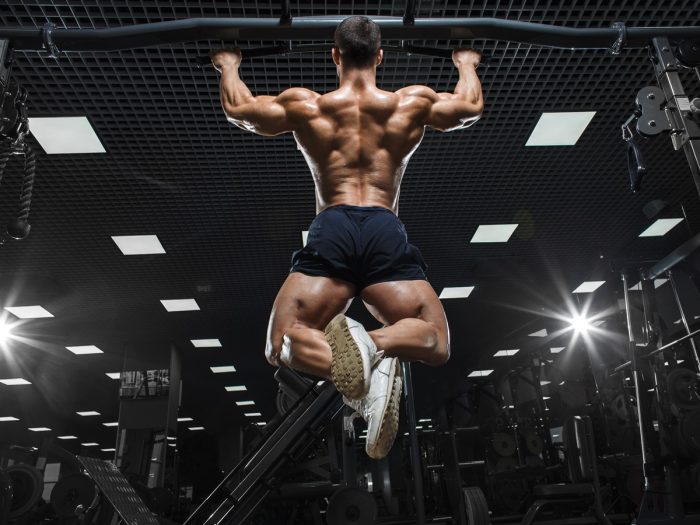Pull-ups are some of the most difficult and effective exercises for targeting certain muscle groups in the body. By definition, pull-ups are a bodyweight exercise that consists of pulling yourself up from a prone position to a bar or other handle situated above your head. You are essentially pulling your own body straight up to where your chin passes the bar and your elbows are positioned directly beneath your shoulders.
This exercise has a number of variations, and also goes by various names, such as chin-ups, but this alternate title normally refers to pull-ups where the palms are facing away from the body. You can also vary your pull-ups based on hand width separation, crossing the legs and bending the knees. This exercise is one of the most common measurements of athletic ability and is widely used everywhere, from high school physical fitness tests to strength and conditioning for military groups, such as the Marines. [1]
Benefits of Pull-ups
Some of the most important benefits of pull-ups include their effects on the strength of your joints and muscle endurance and are preferred due to their flexibility and convenience, among others.

Pull-ups exercise your joints, grip, and muscle strength. Photo Credit: Shutterstock
Joint Strength
Slow and carefully controlled pull-ups are excellent for improving joint strength in your wrists, elbows, and shoulders, which can decrease your risk of sprains and pulled muscles. [2]
Muscle Endurance
These simple exercises can be extremely taxing on your muscles in a very short time. As you gradually increase the number, even small improvements represent a significant boost in your muscle strength. [3]
Abdominal Muscles
While performing pull-ups, particularly as the other muscle groups begin to tire, your core will be engaged and your abdominal muscles kick into action. These are also important in controlling momentum and swinging during the exercise. [4]
Latisimmus Dorsi
These are your primary back muscles, between your shoulders, that determine the width of your back and are engaged and strengthened with pull-ups. [5]
Arms & Shoulders
Pull-ups require a great deal of upper body strength, as well as endurance in your shoulders, biceps, triceps, forearms, and hands, all of which get a significant workout during these exercises. [6]
How to Do Perfect Pull-ups?
If you want to do the perfect pull-up, there are some simple steps you can follow to get the most out of your workout.
- Stand beneath the bar and establish a firm grip on it, with your hands and shoulder-width apart, your palms facing outward.
- Lift up your legs so you are in a dead hang before beginning the pull-up. Do your best to keep your body still and straight during each rep, in order to minimize how much your legs and hips swing.
- Slowly pull yourself straight up until your chin passes the bar and you bring your chest to meet the bar. At this point, your elbows should be directly beneath your shoulders, tucked in against your body.
- Slowly lower yourself back into a dead hang position, again trying to keep your legs still. Don’t drop yourself down, as this relinquishes control of your muscles during the descent, and can also be jarring on your shoulders, elbows, and wrists.
Pull-up Types
There are a few popular pull-up types, and unless you are a professional that is looking for the ultimate pull-up challenge, these basic variations should be sufficient. Aside from the basic pull-up explained below, other options include commando pull-ups, wide-grip pull-ups and behind the neck pull-ups.
Commando
Stand under the bar with the bar lengthwise above you. Reach up and clasp the bar with your hands staggered, and then pull yourself up, leaning your head to alternating sides as you touch the bar to your back.
Wide Grip
Instead of shoulder width apart, widen your grip another 4-5 inches. This will be a more intense workout for your back and should target different muscle groups.
Behind the Neck
This is a difficult variety of your basic pull-up where you duck your head under the bar as you pull up, touching the bar to the back of your neck.
Pull-ups for Beginners
If you are just starting out on learning how to do pull-ups, there is no need to complete the entire exercise, as this can make it far more difficult to achieve a single rep. However, if you limit yourself to chin-ups, meaning that only your chin clears the bar before allowing yourself back down, you can work out the key muscles without finishing the full pull-up. [7]
Furthermore, on the way down, don’t allow your elbows to lock in a dead hang position, as this can be very hard for beginners to pull out of. On your descent, wait until your elbows form a 90-degree angle and then pull back up to clear your chin. Over time, you can increase how far you pull up and how far you allow your body to drop between reps.
What Muscles Do Pull-ups Work Out?
The primary muscle group that pull-ups target is the Lattisimus dorsi, which is the V-shaped muscle in the center of your back. However, pull-ups also target the abdominal muscles, forearms, hands, shoulders, biceps, triceps, back and chest. This makes the exercise one of the most comprehensive exercises available to those who want to get in shape.
